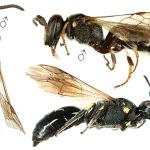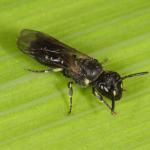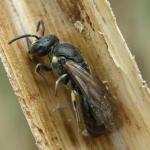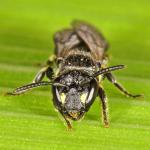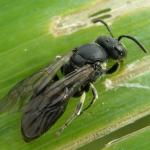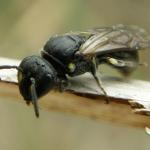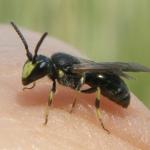Hylaeus kriechbaumeri FÖRSTER 1871; Prosopis palustris PERKINS 1900
There are very few British aculeates which are largely confined to wetland habitats. One of these is Hylaeus pectoralis, a bee which for many years was almost entirely associated with the fens of East Anglia, especially Wicken Fen, Cambridgeshire.
Since the early 1970s this bee has been found from West Sussex to east Devon, the Isle of Wight, Surrey, Essex, Suffolk, Norfolk, Cambridgeshire and Northamptonshire. Most recent records are from the coast of southern England, though it is probably as common (but overlooked) in inland sites in East Anglia, as in former times (see Else 1995d).
Not listed in the British Red Data Book (Shirt 1987) or Falk (1991). It has a restricted distribution and may be nationally scarce.
Owing to its special nesting requirements, this little bee is associated with stands of the common reed, both in brackish and fresh water where it prefers the drier margins of the reedbed.
Single-brooded; June to late September.
This bee has long been known to nest within the vacated galls of the chloropid fly Lipara lucens, which are formed on the main flower stems of the common reed, where their formation prevents flowering. These galls are spindle-shaped and most are about 10 cm in length. The cells are constructed, one above the other, within the empty gall chamber and, as in other Hylaeus nests, the side and end walls of each cell are formed from a secretion of the bee's enlarged salivary glands; on drying, the secretion forms a thin membrane, closely resembling cellophane. One to about eight cells are usually found in a gall, the number largely depending on the size of the gall's chamber. A completed nest is sealed with a substantial plug of compacted, minute leaf fragments. Some nests are occasionally built in dry reed stems (Perkins, 1900; J P Field, pers. comm.). The life cycle of this bee is described in some detail by Else (1995d).
Bramble (Rubus fruticosus agg.), angelica (Angelica sylvestris), hogweed (Heracleum sphondylium), wild carrot (Daucus carota), hawkbit (Leontodon sp.) and perennial sow-thistle (Sonchus arvensis).
The gasteruptiid wasps Gasteruption assectator and G. jaculator have been reared from nests of this bee collected in Britain (Else, 1995d).
Proofed: January 2012


